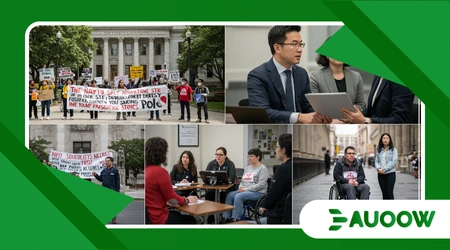The Role of Disability Advocacy Groups in Shaping Public Policy

Disability advocacy groups in shaping public policy have become pivotal forces in driving systemic change, ensuring that the voices of people with disabilities are not just heard but actively shape legislative and societal outcomes.
In 2025, as global societies grapple with evolving political landscapes, these organizations stand at the forefront of advocating for equitable policies that dismantle barriers and promote inclusion.
From grassroots movements to high-level legal battles, their influence reverberates across education, healthcare, employment, and accessibility.
This article explores how these groups navigate complex political terrains, leverage strategic tools like litigation and storytelling, and build coalitions to secure transformative policies.
Why do their efforts matter now more than ever? Let’s dive into their multifaceted role in redefining public policy for a more inclusive future.
The landscape of disability rights has evolved dramatically over the past century, propelled by advocates who refused to accept exclusion as the status quo.
Organizations like The Arc, the National Disability Rights Network (NDRN), and the American Association of People with Disabilities (AAPD) have tirelessly pushed for legislative milestones such as the Americans with Disabilities Act (ADA) of 1990 and the United Nations Convention on the Rights of Persons with Disabilities (CRPD) in 2006.
These groups don’t just react to policy changes; they proactively shape them, ensuring that people with disabilities are not an afterthought but a priority.
Their work is a testament to the power of collective action in challenging systemic ableism and fostering environments where everyone can thrive.
Today, disability advocacy groups in shaping public policy face unprecedented challenges, particularly with initiatives like Project 2025 threatening to roll back decades of progress.
This conservative policy agenda, led by the Heritage Foundation, proposes cuts to Medicaid, weakening of ADA protections, and dismantling of equity-focused programs, posing direct risks to disability rights.
Advocacy groups are countering these threats with innovative strategies, blending traditional lobbying with digital activism and legal interventions.
Their ability to adapt and mobilize is crucial in safeguarding hard-won rights in an era of political polarization.
Historical Foundations of Disability Advocacy
The roots of disability advocacy trace back to pivotal moments that reshaped societal perceptions.
In 1977, the Section 504 sit-in, led by Judy Heumann, saw activists occupy a federal building for 25 days, demanding anti-discrimination regulations.
This protest catalyzed the implementation of Section 504 of the Rehabilitation Act, a precursor to the ADA.
Disability advocacy groups in shaping public policy during this era laid the groundwork for viewing disability as a civil rights issue, not a medical one.
These early victories were hard-fought, often led by individuals with disabilities themselves.
Ed Roberts, known as the father of the independent living movement, championed community-based living over institutionalization.
++ Accessibility in Disaster Response: Are Emergency Plans Inclusive?
His work inspired organizations like The Arc to push for policies ensuring community integration. By framing disability as a societal issue, advocates shifted policy focus from charity to rights-based frameworks.
The momentum from these efforts carried into the 1990s, culminating in the ADA’s passage.
Advocacy groups collaborated with lawmakers, sharing personal stories to highlight the need for accessible public spaces and employment protections.
Their strategic storytelling transformed abstract policy into tangible human experiences, making inclusion a legislative priority.

Legal Advocacy: A Cornerstone of Change
Legal advocacy remains a powerful tool for disability advocacy groups in shaping public policy. Organizations like the Disability Rights Education and Defense Fund (DREDF) use litigation to enforce existing laws and challenge discriminatory practices.
In 2024, DREDF filed amicus briefs in cases defending Medicaid’s role in community-based services, countering proposals to impose work requirements or funding caps.
Litigation often complements legislative advocacy. For instance, when Project 2025 proposed eliminating “disparate impact” regulations rules that address unintentional discrimination groups like the NDRN intervened in court to preserve these protections.
Also read: How Urban Planning Policies Ignore People with Mobility Challenges
Such actions ensure that policies reflect the real-world needs of people with disabilities, from accessible transportation to workplace accommodations.
Beyond courtrooms, advocacy groups draft position statements to guide policy.
The Arc’s statements, for example, outline clear goals for education and healthcare access, influencing both local and federal legislation. These documents serve as roadmaps, aligning grassroots efforts with national policy objectives.
Building Narratives Through Storytelling
Storytelling is a potent weapon for disability advocacy groups in shaping public policy.
By amplifying personal experiences, advocates humanize complex issues, making them relatable to policymakers and the public.
In 2025, influencers like Haben Girma, a deafblind lawyer, use platforms like X to share stories of navigating inaccessible systems, highlighting the need for digital accessibility.
Consider the case of Maria, a wheelchair user who campaigned for accessible public transit in her city. Her story, shared by the AAPD, prompted local officials to prioritize ramp installations at bus stops.
Read more: Disability and Voting: Are Polling Stations Really Accessible?
Such narratives bridge the gap between policy and lived experience, driving measurable change.
Advocates also leverage media to reshape perceptions. The 2020 documentary Crip Camp showcased the disability rights movement’s origins, inspiring a new generation of activists.
By controlling the narrative, disability advocacy groups in shaping public policy ensure that disability is seen not as a limitation but as a facet of human diversity.
Coalition-Building and Cross-Movement Solidarity
No movement thrives in isolation. Disability advocacy groups in shaping public policy excel at forming coalitions with other marginalized communities.
The Center for American Progress’ Disability Justice Initiative, for example, collaborates with reproductive health and immigration advocates, recognizing shared struggles against systemic inequities.
This cross-movement approach amplifies impact. In 2025, the NDRN partnered with LGBTQ+ organizations to oppose Project 2025’s anti-DEI proposals, which threaten protections for both groups. By uniting, they create a stronger front against policies that undermine equity.
Coalitions also foster the “curb-cut effect,” where disability-focused policies benefit broader populations.
For instance, accessible sidewalks, initially advocated for by disability groups, aid parents with strollers and delivery workers. This interconnected advocacy underscores the universal value of inclusion.
Navigating 2025’s Policy Challenges
The current political climate poses unique challenges for disability advocacy groups in shaping public policy.
Project 2025’s proposals, including Medicaid block grants and reduced ADA enforcement, threaten to reverse decades of progress.
A 2024 report from the Center for American Progress noted that 26% of U.S. adults report disabilities, underscoring the scale of impact these policies could have.
Advocacy groups are responding with agility. The Arc launched a 2025 campaign urging supporters to contact Congress, emphasizing Medicaid’s role in independent living.
Their grassroots efforts ensure that policymakers hear directly from constituents, amplifying the urgency of preserving safety nets.
Digital platforms have also become battlegrounds. Groups like Disability Rights North Carolina use X to counter misinformation about disability programs, engaging younger audiences.
This blend of traditional and modern advocacy keeps the movement dynamic and responsive.
Digital Activism: A New Frontier
The rise of digital tools has transformed advocacy. Disability advocacy groups in shaping public policy harness social media to mobilize supporters and influence lawmakers.
In 2025, platforms like X enable real-time engagement, allowing advocates to share policy updates and rally support instantly.
For example, the Autistic Self Advocacy Network (ASAN) uses online campaigns to promote neurodiversity in education policies.
Their 2024 virtual march garnered thousands of participants, highlighting issues like inclusive classrooms. Digital activism overcomes physical barriers, enabling broader participation.
Yet, challenges persist. A 2024 scoping review found only 54 of 18,069 academic abstracts addressed online disability activism, indicating under-researched potential.
Advocates must navigate digital divides, ensuring accessibility for all, including those with limited tech access.

Empowering Communities Through Education
Education is a critical battleground for disability advocacy groups in shaping public policy. The Individuals with Disabilities Education Act (IDEA) ensures free, appropriate education for students with disabilities.
Advocacy groups like The Arc co-chair the CCD Education Task Force, advocating for proper IDEA funding and implementation.
In 2025, groups are pushing back against proposals to divert IDEA funds to private school vouchers, which often lack disability accommodations.
Their efforts ensure that public schools remain inclusive, offering tailored support for diverse needs.
Workshops and conferences also empower communities.
The 2025 Disability Rights North Carolina conference, themed “Everyone at the Table,” fosters dialogue on inclusion, equipping advocates with tools to influence local policies.
Table: Key Disability Advocacy Milestones
| Year | Milestone | Impact |
|---|---|---|
| 1977 | Section 504 Sit-In | Enforced anti-discrimination regulations |
| 1990 | ADA Passage | Prohibited discrimination in public life |
| 1999 | Olmstead Decision | Affirmed right to community-based living |
| 2006 | UN CRPD Adoption | Set global disability rights standards |
The Global Perspective
Disability advocacy extends beyond borders. The UN’s CRPD, ratified by over 180 countries, sets a global standard for disability rights.
Disability advocacy groups in shaping public policy draw inspiration from international models, adapting strategies to local contexts.
In Sweden, advocacy groups leverage social media to promote normalization principles, ensuring disability policies prioritize citizenship.
These global lessons inform U.S. advocates, who adopt similar digital strategies to amplify their impact.
International coalitions also strengthen advocacy.
Organizations like Human Rights Watch collaborate with local groups to address global challenges, such as climate change’s disproportionate impact on people with disabilities, ensuring policies are inclusive worldwide.
A Call to Action
The work of disability advocacy groups in shaping public policy is akin to planting seeds in a garden each effort cultivates a more inclusive future.
These groups don’t just advocate; they redefine what’s possible, ensuring that policies reflect the dignity and potential of every individual. As threats like Project 2025 loom, their role is more critical than ever.
Imagine a world where accessibility is a given, not a privilege. That’s the vision driving these advocates. Their successes from the ADA to Olmstead prove that change is possible when voices unite.
Join the movement, share your story, or support organizations like The Arc and DREDF. Together, we can build a society where everyone belongs.
Frequently Asked Questions
What is the role of disability advocacy groups in shaping public policy?
They influence legislation, challenge discrimination through litigation, and amplify community voices to ensure inclusive policies.
How do advocacy groups use storytelling effectively?
They share personal narratives to humanize issues, making policy impacts relatable and compelling for lawmakers and the public.
What challenges do advocacy groups face in 2025?
Threats like Project 2025’s proposed cuts to Medicaid and ADA protections demand strategic responses to safeguard rights.
How can individuals support disability advocacy?
Engage with organizations, share stories, vote for disability-friendly policies, and participate in grassroots campaigns.
